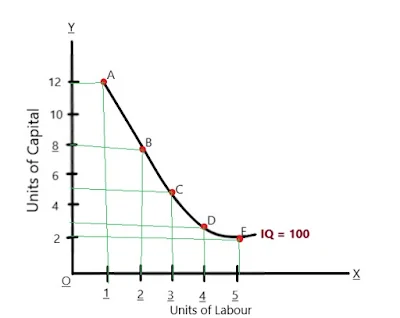Isoquant:
Isoquant has been derived from the Greek word ‘iso’ meaning ’equal’ and Latin word ’quant’ meaning’ quantity ‘. Therefore, the Isoquant is also known as equal product curve or production indifference curve. An Isoquant is defined as the locus of the point representing different combinations of two inputs (labor and capital) giving the same level of output.Assumptions:
- There are only two inputs (labor and capital) to produce a commodity (let x)
- The two inputs (L, K) can be substituted from one another at a diminishing rate up to a certain limit.
- The production function is continuous. I.e. labor and capital are perfectly divisible.
The above schedule shows the different combinations A, B, C, D and E which can produce 100 units of x commodity. The combination A consists of 1 unit of labor and 12 units of capital. Similarly, a combination of B consists of 2 units of labor and 8 units of capital and so on. All five combination of inputs produces the same amount of output I.e. 100 units. It can be presented in the graph as follows:
In the above figure the point A, B, C, D and E on the isoquant IQ shows 5 different combinations of labor and capital but all these combinations yield the same level of output I.e. 100. The movement from A to E indicates decreasing quantity of capital and the increasing quantity of labor. This means the substitution of labor for capital which yields the same level of output along the isoquant IQ.



0 Comments
If this article has helped you, please leave a comment.